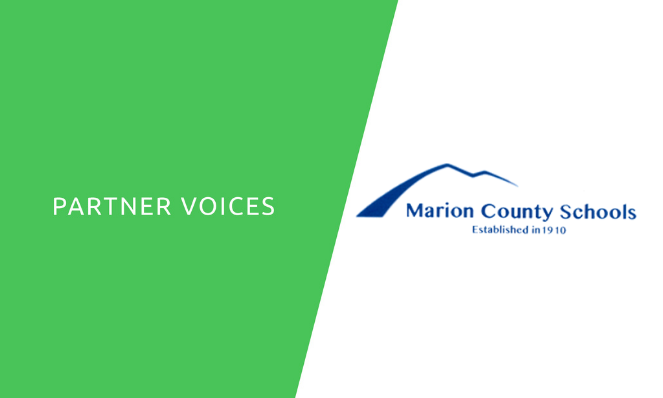
Partner Voices: Marion County Schools Assistant Director Dr. Larry Ziegler
Our partners in school systems across the country are sharing their experiences of the challenges and successes of teaching, learning, and leading in the time of COVID-19.
Dr. Larry Ziegler, Assistant Director of Marion County Schools, spoke to Mia Dunlap, Director of Instructional Support at Instruction Partners, to reflect on the first chapter of distance learning and share his team’s priorities for school reentry planning. Marion County Schools is a rural school district located in East Tennessee.
Watch the full conversation or read the abridged Q&A below.

MD: We are excited to learn from you. What was your experience like with distance learning for your schools?
LZ: The closure came about during our spring break. It was a blessing that the closure occurred during their spring break, which gave us a little time to coordinate everything. We had a digital platform ready to use the first day of closure, and we also had paper packets ready for them to pick up if they did not have digital access. We distributed those packets at our food sites. We had real good participation—almost 87% of our students participated in one form or the other through those two platforms. It was not perfect by any means, but in a tight window, we felt like our teachers and our instructional leaders did a great job getting instruction in the hands of our parents and our students during this unforeseen closure.
MD: It sounds like you all really took care of your students and families. And then to hear that you had 87% participation, wow! How did you gauge what was considered participation?
LZ: Our teachers made the commitment to reach out to every one of their students at least weekly. During those touch points we could measure who was doing the digital platform, who was picking up the packets, and who was returning the packets. The multiple means of the platform, talking to our teachers, and packet returns is where we came up with a number of 87% participation.
FEATURED LEADERSHIP TOOL:
MARION COUNTY SCHOOLS REENTRY PLANNING TEMPLATE
MD: I love it, it sounds like students were super engaged during that time. What tools are you taking with you into the fall and summer to help maintain this success?
LZ: We’ve learned just as much from failure as success, to be honest with you. We did a parent survey near the end of school to get their feedback on what went well with distance learning and what we could do better as a school system. One of our biggest takeaways, and we knew this would be a takeaway, was that our amazing teachers need to be providing direct, explicit instruction to our students. We’re using this summer to prepare and make plans for if we have another closure or if school looks different in the fall, so that we have means in place for our teachers to provide the direct explicit instruction and for it to be interactive. When you have student to teacher engagement, and student to student engagement, that’s when the learning occurs.
Another big thing is that we have to be flexible. We have to plan for different scenarios. We have to plan for areas of our rural community that do not have internet or data access. We have to look at multiple scenarios because there’s not one answer to distance learning and everything else we’re dealing with at this time.
MD: And goodness we wish there was just one answer to solve all of our problems with this, but you’re right, there isn’t just one. Can you talk more about what you are all doing in the fall to help teachers maintain engagement with students?
LZ: For the last three weeks, we’ve been working with Instruction Partners on supporting our teachers with the implementation of our new ELA curriculum, and continuing the implementation of our math curriculum. We’re building in with that implementation work all the different scenarios that we could be faced with in the fall. We’re preparing teachers to stream directly out to students with that direct, explicit instruction. We did our implementation training in a way where if I’m teaching 25 students in my classroom, it’s going to look the same as if I’m teaching 25 kids sitting at home. The nuts and bolts of instruction will be the same. The delivery mechanisms are a little different, but high-quality instruction is high-quality instruction. That’s how we feel. At the district level, we’ll work out the delivery methods for our teachers. We just want them focused on being comfortable with this new curriculum and providing the instruction.
One scenario that has been weighing on us is how we will reach those students without internet connections and data connections if they have to stay at home in the fall. When our teachers stream, we will record those streaming sessions. Then, those recorded sessions will be delivered to the students who do not have access. We will provide them with a device and the recorded instruction to watch and teachers will be reaching out to them to provide additional support where needed. We’re just trying to be very flexible about how to get direct instruction to our students, because nothing will ever replace a high-quality teacher. We’re just working hard to make sure that we can get our teachers’ faces and voices to our kids in whatever scenario we’re faced with.
MD: I love the way you value and appreciate your teachers and know their significance. You talked about some of your most vulnerable students in terms of students who may not have access to connect to technology. What are some other ways that you’re thinking about supporting students who have IEPs or disabilities during this time?
LZ: We’re going to have another level of that direct interaction, where they’re not only getting direct instruction from their regular teacher, but they’ll also get direct instruction to provide those skill needs and the language needs. That might look a little different for each child with different needs, but our commitments are the same as our commitment for all other students in that we want adult-to-student interaction. I truly believe that we’ve got to talk to each other, we’ve got to see each other’s faces. I just think that’s what kids need. That’s what adults need. So we’ll work individually with those students, and if any are at home in the fall, we’ll make sure their needs are met.
MD: That’s so important to hear you thinking about the different layers of support that will be necessary for students to be successful upon the return of school. This fall, what model do you imagine will be true—at-home, hybrid, or on-site?
LZ: We’re talking with other rural districts in the area and we feel that the majority of our students and faculty and staff will be back at school, and our high risk teachers, our high risk students, and our high risk staff will work from home. So, we’re looking at our model as a flexible hybrid model, where we’re providing on-site instruction and at the same time streaming that instruction out to any student who is not healthy and safe in the on-site setting. So it’s hybrid flexible, but we’ve got our fingers crossed that the majority of students and the majority of faculty and staff are back on site. We’ve decided on that plan to stream the recording of lessons because it works if 90% of our kids are at school and 10% are at home, or if 100% of our students are at home. We tried to come up with a plan so that no matter what the scenario we were dealing with in the fall, the plan we have can either be scaled up or scaled down to meet the needs at that time.
MD: What would you say have been the most helpful resources from Instruction Partners in preparing for the summer and fall?
LZ: I tell you the most important resource to us is not one you hold in your hands, but it’s having a thought partner who is willing to push back on your thoughts. We’re a small rural district. Most of our faculty and staff were born here, went to school here, and we’re not leaving home. So, just to have those outside thought partners for us to be able to share what we’re doing and to get their perspective has been huge. They share research with us. Our reentry plan was built hand-in-hand with them, and our curriculum implementation plan has been built hand-in-hand with them. Everything we’ve done with Instruction Partners has exceeded our expectations. They went above and beyond to support us with our implementation of curriculum, with our reentry planning, and any area of support we’ve needed. It feels like a true partnership where they’re invested in our kids just as much as we’re invested in our kids. It’s been an amazing experience that we just hope to continue to build and do the best we can for our kids.
MD: That is awesome. What advice would you give for folks who are planning for reentry this fall, in whatever context that might be?
LZ: it’s being flexible. That’s something that our school district has not always been. We’ve had our way of doing things, but there are several different ways to get the results you want. And it doesn’t always have to be the way it’s always been done. Just be flexible and be open to different ways of accomplishing your goal. Our goal is student outcomes. Our number one focus is to keep our kids and our faculty and staff safe and healthy. That’s number one. But then after that, it’s about providing them with the instruction and the support they need to reach their goals in life. I don’t think anyone has the answer, but I look at all the different scenarios, and listen to as many people as possible. Everyone can develop a plan that’s best for their students, best for their communities, to accomplish the goal to prepare kids for their life after us. That’s my biggest takeaway from this entire experience that we’ve been through and that we’re still going through.


